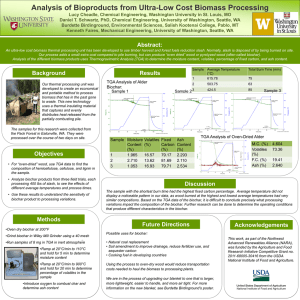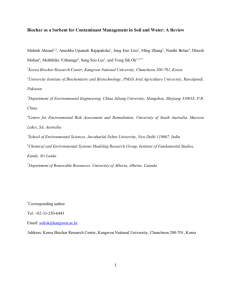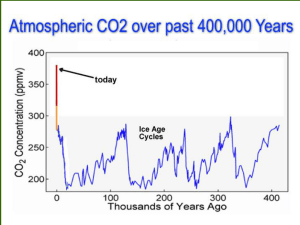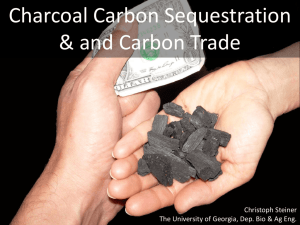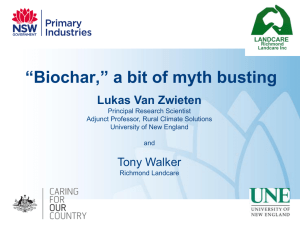Biochar from Biomass and its Potential Agronomic and Environmental Use in Washington:
advertisement
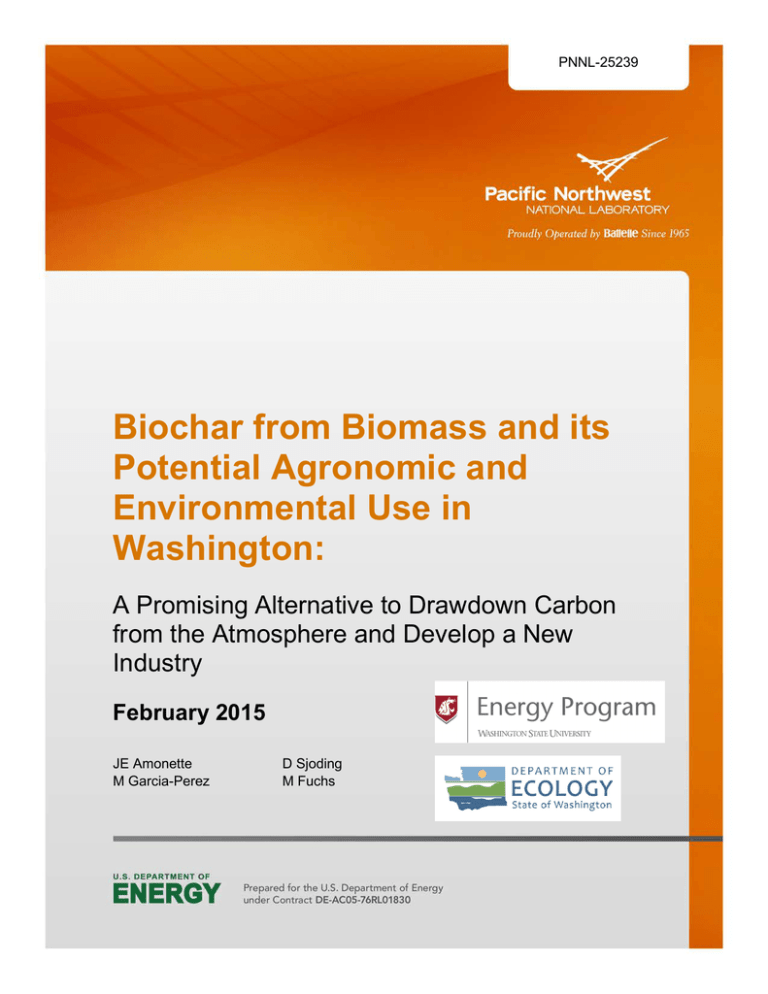
PNNL-25239 Biochar from Biomass and its Potential Agronomic and Environmental Use in Washington: A Promising Alternative to Drawdown Carbon from the Atmosphere and Develop a New Industry February 2015 JE Amonette M Garcia-Perez D Sjoding M Fuchs Biochar from Biomass and its Potential Agronomic and Environmental Use in Washington: A Promising Alternative to Drawdown Carbon from the Atmosphere and Develop a New Industry by J.E. Amonette1, M. Garcia‐Perez2, D. Sjoding3 and M. Fuchs4 1 Pacific Northwest National Laboratory, Richland, WA jim.amonette@pnnl.gov 2 3 Washington State University, Pullman, WA mgarcia-perez@wsu.edu Washington State Energy Program Office, Olympia, WA SjodingD@energy.wsu.edu 4 Washington Department of Ecology, Spokane, WA mfuc461@ecy.wa.gov Summary Climate change is one of the most serious issues facing the world today. Increasing concentrations of carbon dioxide (CO2) and other long-lived greenhouse gases (GHGs) in the atmosphere continue to warm the planet and destabilize the climate. It has been estimated that the impact from this warming could cost the state $10 billion per year by 2020, and $16 billion per year by 2040. Long-term solutions to the climate problem likely will require that large quantities of CO2 be removed from the atmosphere. In fact, massive CO2 drawdowns from the atmosphere have occurred in earth’s recent past from events occurring in our hemisphere. Studies of those analogs provide insight into the potential magnitude for specific actions to drawdown significant CO2 from the atmosphere. One of these potential actions is the large-scale production of biochar from abundant woody biomass waste and its storage in soils, where it remains stable for hundreds to thousands of years. Moreover, for the carbon emission intensity of Washington’s fuel mix, biochar production from biomass is twice as effective in offsetting GHG emissions as complete biomass combustion of the same biomass. Washington State has large quantities of wood waste biomass that could be purposed for production of combined heat/power/biochar (CHPB) through existing biomass boilers. We propose to 1) evaluate the quantities of Washington wood waste biomass, 2) inventory existing boiler capacity and assess the technical merits and challenges to repurpose the boilers to CHPB, and 3) apply literature values and analog biochar examples to better quantify the extent of CO2 drawdown that could be achieved in Washington State over the next century using engineered biochar. This white paper explores the potential to replicate the historical drawdowns of atmospheric CO2, a topic the authors think should be part of current climate-change mitigation discussions. This document is a companion to a white paper titled Biochar from Wood Biomass and Agricultural Residues and its Potential Agronomic Use in Washington: A Tool to Improve Irrigation Water Use Efficiency, Energy Efficiency and Sequester Carbon (Amonette, et al., 2016, in preparation). i Contents Summary ........................................................................................................................................................ i Introduction .................................................................................................................................................. 1 Biochar Properties and Beneficial Uses ........................................................................................................ 3 Climate Change Mitigation ....................................................................................................................... 3 Industrial Applications .............................................................................................................................. 6 Agricultural Applications ........................................................................................................................... 6 Biomass Resource ......................................................................................................................................... 7 Biochar Production Capacity ......................................................................................................................... 7 Summary of Benefits..................................................................................................................................... 8 What Needs to be Done Now? ..................................................................................................................... 9 References .................................................................................................................................................... 9 Appendix: Preliminary Atmospheric CO2 Drawdown Calculations for Washington State.......................... 11 ii Biochar from Biomass and its Potential Agronomic and Environmental Use in Washington: A Promising Alternative to Drawdown Carbon from the Atmosphere and Develop a New Industry J.E. Amonette1, M. Garcia‐Perez2, D. Sjoding3 and M. Fuchs4 1 Pacific Northwest National Laboratory, Richland, WA 2 Washington State University, Pullman, WA 3 Washington State Energy Program Office, Olympia, WA 4 Washington Department of Ecology, Spokane, WA Introduction Climate change, caused primarily by increases in the atmospheric concentrations of carbon dioxide (CO2) and other greenhouse gases (GHGs), is one of the most serious issues facing the world today. Although the most severe impacts will likely be felt in other parts of the world, Washington State’s environment and economy will, nevertheless, be affected significantly by climate change as a result of increased health care costs, storm damage, coastal destruction, rising energy costs, increased wildfires, drought, decreased snowpack, and other impacts. The potential cost of these impacts to Washington State has been estimated at $10 billion per year by 2020, and $16 billion per year by 2040 (Washington State Department of Ecology [Ecology], 2012). While the present discussion focuses on Washington, it is easily applicable to other states in the Pacific Northwest. Responses to climate change include adaptation and mitigation. We must certainly adapt, as several decades are needed for the global climate system to adjust to a given set of conditions. We must also mitigate if we are to spare future generations the perils of a much warmer world. Mitigation includes decreasing emissions of GHGs, but will also include the removal of GHGs from the atmosphere in order to return the concentrations to levels considered safe. For the chief GHG, carbon dioxide (CO2), safe levels are at least 50 ppm lower than today’s concentration of 404 ppm (Hansen et al., 2008; Rockstrom et al., 2009) and perhaps as much as 100 ppm lower. The Earth’s biosphere processes about 16% (64 ppm) of atmospheric CO2 each year, but half of this is immediately returned to the atmosphere as a result of plant respiration. Most of the remainder is returned as a result of biomass decomposition. The overall scale of the biosphere/atmosphere interaction, however, suggests that manipulating the biosphere might offer a mitigation potential large enough to meet the challenge faced. Reductions in atmospheric CO2 have occurred in the Earth’s recent past as a result of events in our hemisphere. In a series of papers, Nevle and co-workers (Nevle et al., 2008; 2011; Dull et al. 2010) demonstrated the impact of an extraordinary atmospheric CO2 drawdown following a massive human pandemic and demographic collapse in Central and South America between 1 1525 AD and 1650 AD. The resulting regrowth of tropical forests stored nearly 40 Pg of C, mostly transferred from the ocean via the atmosphere, and accounted for a net reduction of 59 ppm in the atmospheric concentration of CO2. Prior to the demographic collapse, however, human activity in the Americas had led to the accumulation of large quantities of black carbon in soils that significantly enhanced their fertility. For example, Krug and Hollinger (2003) showed that soils of the Illinois Plain developed with extraordinary fertility and high concentrations of carbon as a result of Native American practices of landscape-scale burning to maintain savannah-like conditions favoring forage production. Similar enhancements to soil fertility occurred in the Amazon region of South America as a result of burial of charcoal together with animal bones and human waste. The resulting dark soils, the so-called Terra Preta do Indio, sustained a large population until the pandemic that followed first contact with Europeans (Mann, 2002). These two sets of studies confirm that human management of biomass on a large scale, whether intentional or not, can have a significant impact on the Earth’s climate system. The intentional adoption of modern biomass practices that can sequester carbon, improve soil fertility, and generate energy to offset fossil emissions thus could be a major weapon in the fight against climate change. One such practice is the production of biochar from waste biomass resources. As shown by Woolf et al. (2010), large-scale adoption of modern biochar production from sustainably procured biomass could offset about one seventh of current anthropogenic GHG emissions. Over the course of a century, global production of biochar by modern technologies could store the equivalent of 15-30 ppm atmospheric CO2 directly as biochar carbon in soils and avoid an additional increase of 15-30 ppm CO2 equivalent by replacing fossil-fuel sources of energy and preventing emissions of methane and nitrous oxide by decaying biomass. These values do not take into account the probable buffering effects of the oceanic pool of CO2, which, in keeping with the previous event several hundred years ago, would likely replace about 75% of the atmospheric CO2 stored/offset by modern biochar technology. In order to determine the potential contribution to the effort against climate change that can be made from biochar systems in Washington State, an accurate assessment of available biomass resources is needed. Here, the likely focus would be on woody biomass “waste” resources that are currently disposed or underutilized. A second need is for an assessment of the potential biochar production capacity, including an inventory of existing biomass boilers and the modifications that would be required for biochar and power production. Finally, with knowledge of the biomass resources and production capacity that are available, an accurate estimate of the potential impact that adoption of the biochar approach in Washington State could have on atmospheric levels of GHGs over the next century can be made. For this estimate, information about the current soil resource, biomass productivity responses to biochar amendments, and interactions with the broader climate system, including the oceans, would need to be integrated with the biomass and production capacities into a predictive model. 2 In what follows, we discuss some of the properties of biochar and its beneficial uses for climatechange mitigation, industry, and agriculture, and what is known about the biomass resource and biochar production capacities in Washington State. Biochar Properties and Beneficial Uses Climate Change Mitigation Currently, global soils are estimated to contain about 3 times as much carbon as occurs in the atmosphere, and 4.5 times as much as is contained in living organisms. Historically, soil carbon was much higher than it is today. “According to Rattan Lal, director of Ohio State University’s Carbon Management and Sequestration Center, the world’s cultivated soils have lost between 50 and 70 percent of their original carbon stock, much of which has oxidized upon exposure to air to become CO2” (Schwartz, 2014). This important observation leads to the following conclusions: • Soils have a demonstrated capacity to store vast quantities of carbon in long term stable forms. • Since natural processes built these soil-carbon stores, we conclude that soil carbon loss can be systematically reversed with specific actions. • Stable soil carbon can be actively put back into soils by emulating and perhaps improving on nature’s soil-carbon storage mechanism. • In addition to carbon drawdown, placing biochar in urban and agricultural soils would provide added functions, increasing water holding capacity, improving productivity and removing contaminants from water through biochar’s sorptive properties. In a recent paper, Smith (2016) evaluated soil carbon storage (SCS) technology, which includes the suite of land management practices that enhance formation and retention of soil organic matter,and biochar technology, which includes the pyrolysis of biomass to produce energy and the subsequent storage of the solid product (biochar) in soil, relative to other carbondrawdown technologies. This work showed that SCS and biochar have 1) similar carbondrawdown potentials that are lower than most of the other technologies and 2) fewer disadvantages than the other technologies. While SCS suffers from the potential for early soil saturation after only a few decades and is subject to reversibility from changes in landmanagement practices, biochar could be implemented at higher land application rates and in combination with carbon capture and storage to achieve even greater drawdown of CO2. Smith (2016) argued strongly for the inclusion of these two approaches in the integrated assessment models used by scientists to understand the potential impacts of mitigation options on climate. Soils within Washington State have the potential to store vast quantities of carbon. A recent report by Ecology (2015) shows that Washington cropland soils (i.e., cultivated land in annual or perennial crops) total 7.6M acres (3.08M ha). Of this vast acreage many of the soils are naturally low in carbon (organic matter). Cultivation has also reduced soil organic matter in 3 large tracts of the cropland acreage. And, the less developed younger soils in central Washington (Columbia Plateau) contain much less than 3% organic matter. This offers a significant opportunity to store carbon in the form of biochar. These same soils are also the highly irrigated areas of central Washington offering huge potential for the improvements that biochar can bring in irrigation and fertilizer-use efficiency. The resulting increases in soil fertility and agricultural output would also have an immediate positive impact on the state economy. While agricultural soils offer the potential for tremendous carbon storage, the National Association of State Foresters (2004) reports that Washington forests cover 21.3M acres (8.62M ha) and pasture and rangeland another 4.1M acres (1.66M ha). This additional landscape area multiplies soil carbon storage potential by 3-4 times. Washington has the soil volume to store vast carbon resources and improve soil organic matter (from: http://www.statemaster.com/state/WA-washington/geo-geography). By adding just 2.5% wt. carbon to each hectare of the state cropland soils (50 t/ha or 20 t/acre), 0.62 Gt CO2 equivalent could be stored. This results in approximately 0.020 ppm global atmospheric CO2 drawdown potential after accounting for replacement of atmospheric CO2 by CO2 exsolved from the ocean. For perspective: a 1 Mt CO2 drawdown, requires 1.02 Mt of biomass, representing the biomass consumed annually at just five pulp plant boilers. Therefore, we believe this CO2 drawdown may be achievable within 100 years. This would result in a huge potential to generate electrical power, heat and other outcomes while also producing the biochar. In addition, this would drive business opportunities and infrastructure, while stimulating hardware and intellectual property development in the state. From a carbon‐footprint perspective, the advantages of fixing carbon using biochar produced by boilers are many. The carbon in the biochar is highly resistant to microbial degradation with half‐lives estimated from centuries to millennia, much longer than would be achieved when standing biomass decays (several years) or even when stored as soil organic matter (several decades). In most instances, addition of biochar to soils cuts emissions of nitrous oxide (a greenhouse gas 300 times more potent than CO2), and biochar adds to the water‐holding and nutrient‐holding capacities of soils. Many biochars also serve as liming agents for soils acidified by heavy use of nitrogen fertilizer. Use of biochar as an admix to composting operations cuts emissions of methane, which is 33 times more potent than CO2 over a 100-year period (86 times more potent over a 20-year period), while at the same time increasing the rate of the compost process. These attributes combine to make the energy produced with biochar carbon‐negative (i.e., more carbon is stored or offset per unit of energy than carbon emitted). A direct global comparison of the climate‐change mitigation impacts of pyrolysis (biochar) and combustion, using the same amount of sustainably procured biomass (Woolf et al., 2010), shows that the relative impacts scale differently with the carbon intensity (CI) of the energy that is replaced by bioenergy produced by the two technologies. That is, if coal production is being offset (CI = 26 kg C/GJ), the two (biomass combusted to energy, and biomass pyrolyzed to biochar) yield comparable mitigation benefits, whereas if natural gas is being offset (CI = 15 kg C/GJ), the benefits of biochar are about 30% greater than those of combustion (Figure 1). 4 Taking the carbon intensity of Washington state as a whole (CI = 8.25 kg C/GJ), the relative climate-mitigation benefit of biochar increases to twice that of producing bioenergy alone from biomass. Preliminary estimates of biochar capacity accounting for biomass availability, biochar production methods and receiving soils concludes that Washington could relatively easily produce and put to beneficial use 2.65x108 tons of biochar, equivalent to 0.62 Gt of CO2 drawdown over the next one hundred years (See Appendix for calculations and discussion). This would yield a net 0.02 ppm global atmospheric CO2 reduction assuming that 75% of the total atmospheric drawdown would be replaced by CO2 exsolved from the ocean. Figure 1. Comparison of the global net avoided emissions over a 100-year time frame for sustainably-procured biomass converted either to biochar or wholly to energy (combustion) as a function of the carbon intensity (CI) of the fuels being offset (Woolf et al., 2010). Black dashed line (Mb) indicates the average CI of the global primary energy supply. Green dashed line (Mb WA) indicates the average CI of the primary energy supply in Washington State. 5 Industrial Applications Production of biochar from biomass boilers results in several major products: heat, power and, under specific boiler-operating conditions, biochar. Other specifically designed processes could alternatively produce synthesis gas and liquid fuel intermediates as well as biochar. The heat can be used to drive electrical power generation, industrial thermal processes, and to heat schools, hospitals, green houses, and lumber kilns, etc., while the electrical power can be used in these same enterprises for cooling and to power irrigation pumps. This makes biomasssourced energy production co-optimized with biochar a highly intriguing and desirable outcome. Ag-Energy (http://ag.energy/), a gasification company in Washington state, is an example of multiple outputs/revenue streams including biochar. Biochar can also serve as a platform to build a new local industry. The biochar produced in the boilers can be engineered to yield a low‐grade activated carbon with potential uses that include the removal of pollutants from storm drains, liquid effluents from anaerobic digestion system, and mercury from stack gases. This, and the potential agricultural applications, both as direct amendments and as part of composting operations, offers additional economic development from the use of biochar technology. The capacity to produce biochar in the state can be an important engine catalyzing the creation of new industries in the region. Agricultural Applications As demonstrated by the continuing drought in California, and the extremely dry winter of 2014/2015 here in Washington (mountain snow-pack at 15% of average, summer drought and record 2015 wildfire season with over 1 million acres burned), climate change will decrease the available irrigation water supply, while increasing pumping electrical demand, use of alternate water resources and the costs of irrigation. Regional hydrologic system water storage is in decline across the inland mountains as well. Climate change is expected to result in dramatic shifts in precipitation seasonality across the Pacific Northwest. Thus, development of effective strategies for managing the precipitation that does fall and for storing moisture in soils, along with much-improved irrigation use efficiency, are of paramount importance to Washington agriculture. Biochar made from woody biomass and field residues has several properties which make a compelling case for its broad use in agriculture to make irrigation much more efficient and greatly reduce electrical consumption for pumping. Biochar greatly improves water holding capacity in soils, particularly droughty sandy soils with little organic matter. Recent studies at Washington State University have shown that biochar applied to Quincy Sand soils have improved soil water holding capacity from 16.9 wt. % for the Quincy Sand soil studied to between 23 and 31 wt. % when bio-chars were added at an application rate of 20 g/kg (~40 t/ha or 2.0% wt/ha furrow slice)(Suliman, et. al., 2016). Amonette found water holding capacity improvements of 15% (pers. commun., 2015), still a significant improvement. The more oxidized biochars were best able to retain the most water, which means that the water holding capacity of biochars likely will increase as they age in soils. This improvement means that less water will need to be pumped to supply crop needs and to maintain viable production through the hottest dry weather. Also among biochar’s attributes is that it improves fertilizer-use 6 efficiency, while sequestering carbon in soils for hundreds to thousands of years, in a form which will continue to provide soil water use improvements. The Northwest Energy Efficiency Alliance (NEEA) launched the Agricultural Irrigation Initiative in 2011 with the goal of reducing agricultural irrigation energy use by twenty percent by the year 2020. NEEA published a series of reports that have more thoroughly reviewed soil characteristics, the capacity to store water, and irrigation energy and water efficiency (NEEA, 2015a). In the overview report NEEA states that “agricultural irrigation uses eighty-five percent of the Northwest’s agricultural electrical energy and five percent of the region’s total electrical energy, which represents a $335 million annual electricity load. Reducing that load by twenty percent would result in an annual savings of $67 million” (NEEA, 2015b). Biomass Resource Washington biomass is already collected in significant quantities by wood recyclers, from construction demolition, land clearing and many other sources, yet many thousands of tons still are landfilled as no consistent long-term demand for the biomass currently exists. A US Forest Product Laboratory research note (FPL-RN-0290, 2003) states that US urban woody biomass production in the year 2000 exceeded biomass harvested from all federal forests. A Washington Department of Ecology (Ecology) Inventory and Bioenergy Assessment (Pacific Region Bioenergy Partnership, 2013) suggests that current waste biomass sources could yield up to 5.8 M bdt of woody biomass annually. Ecology waste-characterization studies report 3.3 M tons/yr woody biomass in the waste stream (Ecology, 2013). While these are significant quantities of woody biomass that would begin to fill the biomass needed for an expansive biochar project, many Ecology managers and staff think that realistic waste woody-biomass quantities far exceed these reported values. Several examples support this conclusion: it is understood that demolition and deconstruction debris materials are currently backlogged and not nearly fully recovered and used. And the demand for hazardous forest fuel reduction around the urban woodland interface is increasing. Typical biomass is expected to exceed 10-15 t/acre. Armed with this basic information, we suggest an aggressive and comprehensive review is needed of the availability of waste woody-biomass that could be dedicated to biochar production with energy or fuel as additional outcomes. Biochar Production Capacity Biochar can be produced in pyrolysis reactors, gasifiers, and boilers. Pyrolysis reactors offer real advantages for bio-char and bio-oil production, but their technical complexity (primarily the effort to avoid oxygen in the reactor) makes them costly to build and operate, and therefore less competitive for heat and bio-char production. Simpler systems that purposely introduce oxygen into the thermochemical reactor (boilers and gasifiers) seem to be better suited economically for bio-char and heat production. While boilers are designed to release biomass chemical energy in the form of heat, it is possible to design and/or modify existing systems to combust the volatile fraction while balancing solid charcoal production and avoiding 7 extensive ash production in the charred biomass. This is achieved by controlling the feedstock moisture content, particle size and contact time between the biomass and resulting biochar and the oxidant (atmospheric oxygen). Since there is a continuum between operational modes (full oxidation and partial oxidation), flexibility can be built into a boiler system to allow optimization for energy, or biochar plus energy production. The current fleet of biomass boilers could be used to obtain heat and power (or modified to recover liquid fuel precursors), while producing large quantities of biochar for soil waterholding capacity and irrigation-efficiency improvements. This has immediate advantages. Large capital expenditures for boilers and collection and processing capacity are already in place. Biomass transport systems are well understood. Also, developments in new commercial gasifiers indicate these small units could dot the landscape taking advantage of field residues at the point of collection. Summary of Benefits The potential benefits of using biochar boiler systems for biomass cogeneration facilities can be summarized as follows: Economic • Development of a biochar industry for agricultural and environmental uses • Ability to switch between biochar and bioenergy optimization modes in response to market forces • Improved crop productivity Hazardous Fuel Reduction and Agricultural Management • As much as a tripling of the biomass collected from waste resources to provide the same energy • Increased water and nutrient holding capacities of biochar‐amended soils • Decreased irrigation electrical costs Carbon Footprint • Begin to reverse losses of carbon to the atmosphere • Store stable carbon in soils for centuries to millennia Leadership • Washington State would become a global leader in reducing carbon from the atmosphere, and in doing so would create extraordinary intellectual and business capital that could create additional opportunity for Washington youth and the state’s future prosperity. 8 What Needs to be Done Now? We propose to conduct a more rigorous review of waste biomass availability and boiler system capacity, and to assemble an estimate of the climate-change mitigation potential of biochar technology in Washington State including the following steps: • • • • • Conduct a thorough survey and assessment of the woody material biomass in current waste collection systems and viable for collection with transportation radii and costs considered. Catalogue and assess the available large- and medium-scale boiler and gasifier systems in Washington State. Evaluate the technical potential for boilers and gasifiers to produce electrical power and biochar on a broad basis, and specify the general modifications required for boiler systems to produce quality biochar. Evaluate paleo-climate and anthropologic models to assess previous cultures’ soil carbon storage that will provide guidance for carbon drawdown. Model the capacity of Washington State cropland soils to sequester biochar carbon over a one-hundred-year period and estimate the resulting atmospheric CO2 drawdown potential. References Amonette, J.E., M. Garcia-Perez, D. Sjoding, and M. Fuchs. 2016 (in preparation). Biochar from Wood Biomass and Agricultural Residues and its Potential Agronomic Use in Washington: A Tool to Improve Irrigation Water Use Efficiency, Energy Efficiency and Sequester Carbon. This is a companion document to this white paper. Beck Carlson Biomass Energy Consultants. 2014. Biomass Cogeneration Feasibility Study at Central Washington University, Ellensburg, Washington. Study conducted for Kittitas County Chamber of Commerce. Dull, R.A., R.J. Nevle, W.I. Woods, D.K. Bird, S. Avnery and W.M. Denevan, 2010. The Columbian Encounter and the Little Ice Age: Abrupt Land Use Change, Fire, and Greenhouse Forcing, Annals of the Association of American Geographers, 100(4):755-771. Hansen, J., M. Sato, P. Kharecha, D. Beerling, R. Berner, V. Masson-Delmotte, M. Pagani, M. Raymo, D. L. Royer, and J. C. Zachos. 2009. Target Atmospheric CO2: Where Should Humanity Aim? Open Atmos. Sci. J., 2:217-231, doi:10.2174/1874282300802010217. Krug, E.C., and S.E. Hollinger, 2003. Identification of Factors that Aid Carbon Sequestration in Illinois Agricultural Systems. Illinois State Water Survey, Contract Report 2003-02, Prepared for the Illinois Council on Food and Agricultural Research (C-FAR). Mann, C.C. 2002. The real dirt on rainforest fertility. Science 297 (5583):920-923. McKeever, D.B., and K. E. Skog. 2003. Urban Tree and Woody Yard Residues, United States Department of Agriculture, Forest Service. Research Note, FPL-RN-0290. McKinsey Global Energy and Materials, July 2009. Unlocking Energy Efficiency in the U.S. Economy 9 NEEA, 2015a. http://neea.org/resource-center/market-research-and-evaluation- reports?topic=df3216e1-8961-4ac1-adbc-4f174e926f50&sort=PublicationDate+DESC NEEA, 2015b. Agricultural Irrigation Initiative: Overview. http://neea.org/docs/defaultsource/reports/agricultural-irrigation-initiative-overview.pdf?sfvrsn=6 Nevle, R.J. and D.K Bird, 2008. Effects of syn-pandemic fire reduction and reforestation in the tropical Americas on atmospheric CO2 during European conquest. Palaeogeography Palaeoclimatology Palaeoecology 264:25-38. Nevle, R.J., D.K. Bird, W.F. Ruddiman and R.A. Dull, 2011. Neotropical human–landscape interactions, fire, and atmospheric CO2 during European conquest. The Holocene 21:853-864. Pacific Region BioEnergy Partnership, 2013. http://www.pacificbiomass.org/ Schwartz, J. D. 04 Mar, 2014. Soil as Carbon Storehouse: New Weapon in Climate Fight. Environment 360, Reporting, Analysis, Opinion & Debate. http://e360.yale.edu/feature/soil_as_carbon_storehouse_new_weapon_in_climate_fight/2744 / Rockström, J. et al. 2009. A safe operating space for humanity. Nature 461:472-475. doi:10.1038/461472a Smith, P. 2016. Soil carbon sequestration and biochar as negative emission technologies Global Change Biology, doi: 10.1111/gcb.13178 Suliman W., J.B. Harsh, N.I. Abu-Lail, A.M. Fortuna, I. Dallmeyer, and M. Garcia-Perez, 2016. Understanding the role of biochar porous structure and surface chemistry in Augmenting Hydrologic Properties of a Sandy Soil. In Preparation, to be submitted to the Journal of the Global Environment. Washington Biomass Inventory, 2013. Found at the Pacific Region Bioenergy Partnership: http://www.pacificbiomass.org/WABiomassInventory.aspx Washington State Department of Ecology. 2012. Preparing for a changing climate. Washington State’s Integrated Climate Response Strategy. Publication no. 12-01-004. Washington State Department of Ecology, 2015. Soil Organic Carbon Storage (Sequestration) Principles and Management: Potential Role for Recycled Organic Materials in Agricultural Soils of Washington State. Publication no. 15-07-005. Washington State Department of Ecology, 2013. Methods for Producing Biochar and Advanced Biofuels in Washington State - Part 4: Literature Review of Sustainability Issues, Business Models, and Financial Analyses. Woolf, D, JE Amonette, FA Street‐Perrott, J Lehmann, S Joseph. 2010. “Sustainable biochar to mitigate global climate change.” Nature Communications 1:56. Article is OPEN ACCESS online at www.nature.com/naturecommunications. 10 Appendix: Preliminary Atmospheric CO2 Drawdown Calculations for Washington State These calculations apply peer reviewed and referenced data for carbon in biomass resources, conversion of biomass to biochar, and conservative estimates of carbon in biochar. Input values element Carbon Oxygen (O2) CO2 Mass (g / mole) 12.011 31.999 44.0098 Ratio carbon dioxide / carbon carbon in biochar * carbon in bone-dry (bd) woody biomass tons biochar / bd ton woody biomass ton CO2 offset / ton CO2 fixed ** Mass ratio 3.664 0.58 0.50 0.42 Woolf et al., 2010 1.1 ton CO2 offset / bd ton woody biomass 0.98 conversions 1x109 tonnes 50 tonnes biochar C / hectare furrow slice 1 hectare (ha) 7.80 Gt CO2 atmos 1 gigaton (Gt) or 1 petagram (Pg) 2.5% soil carbon 0.4047 acre 1 ppm CO2 atmos (Assumes soil bulk density of 1.33 Mg/m3 after biochar addition) Arable land in Washington 7.6 M acres (3.08 Mha) * average C content of biochar in the US. This is a conservative number for Washington, woody biochar can easily be upwards of 75% or more carbon, while field residues would convert to 58% carbon or less in biochar. ** 1.10 t C offset per 1.0 t C fixed in biochar. Woolf et. al. (2010) used C offset for biochar of 1.58 and 1.32 in their analysis of the alpha and maximum sustainable technical potential (MSTP) scenarios. The 1.1 t C offset per t C in biochar is a conservative estimate for Washington woody biomass feedstocks and boiler fleet conversion scenario we propose to evaluate. The assessments inherent in this estimate will be evaluated in the proposed work. 11 A key purpose for this white paper is to begin to understand the potential to actualize biochar in a broad program, with limited capital investments. Using current boiler infrastructure as a base case helps to understand that potential. Woolf et al’s biomass-to-biochar technical analysis would increase the CO2 offset per ton of biochar by 20-38%. Should those technical offsets be achievable through a close assessment of built infrastructure, the estimates proposed in the calculation below would be significantly improved. Thus, more biochar and stable C could be available from less woody biomass. 1. Calculation of CO2 offset by biochar: • (1.1 t CO2 offset/t CO2 fixed)*(3.664 t CO2 fixed/t C fixed)*(0.58 t C fixed/t biochar) = 2.34 t CO2 offset/t biochar • (1 t CO2)/(2.34 t CO2/t biochar) = 0.428 t biochar To get 1 t CO2 offset, we will need 0.428 t biochar. • (0.428 t biochar)/(0.42 t biochar/bone dry tonne (bdt) biomass) = 1.02 bdt biomass To get 1 t CO2 offset, we will need 1.02 bdt biomass. 2. Calculation of potential biochar production in WA with existing conservative biomass estimates: • (2.99 M bdt (3.3 M bd short tons1) waste woody biomass/year)*(0.42 t biochar/bdt woody biomass) = 1.26 Mt biochar/year • (5.26 M bdt (5.8 M bd short tons1) waste woody biomass/year)*(0.42 t biochar/bdt woody biomass) = 2.21 Mt biochar/year Current estimates of available woody biomass suggest that between 1.26 and 2.21 Mt biochar/year could be produced 1 - range of available woody biomass feedstock (from Ecology reports). 3. CO2 drawdown potential over 100 years for Washington State using agronomic lands and existing waste woody biomass estimate: • (2.34 t CO2/t biochar)*(2.21x106 t biochar produced/year)*(100 years) = 0.517 Gt CO2 offset in 100 years equivalent to about 0.066 ppm of CO2 drawdown from the atmosphere. • BUT, exsolvation of CO2 from the ocean would likely decrease the net drawdown to 0.017 ppm 12 4. Calculation of agronomic acreage potential for carbon storage over 100 years: For max potential assume total of 50 t biochar-C/ha to be applied in the top 15 cm of soil (plow layer) over the course of a century. • (50 t C in biochar/ha)*(1 t biochar/0.58 t C in biochar) = 86.2 t biochar/ha applied over 100 years. • (86.2 t biochar/ha)*(7.6M acres)*(0.4047 ha/acre) = 2.65x108 t biochar Washington soils have a total storage capacity 2.65x108 t of biochar over 100 years. • (2.65x108 t biochar)/(2.21x106 t biochar produced/year) = 120 years of biochar storage capacity in Washington if high current waste woody biomass estimate is taken. • Technologies to incorporate biochar at greater depth in soils could increase this potential carbon storage several-fold 5. Maximum CO2 drawdown potential for Washington State using agronomic lands and total biochar storage capacity: • (2.34 t CO2/t biochar)*(2.65x108 t biochar stored) = 0.620 Gt CO2 offset • equivalent to about 0.08 ppm of CO2 drawdown from the atmosphere • exsolvation of CO2 from the ocean would likely decrease the net drawdown to 0.02 ppm • addition of forest and pasture lands, coupled with deeper incorporation technologies, could increase these values by as much as an order of magnitude 13

